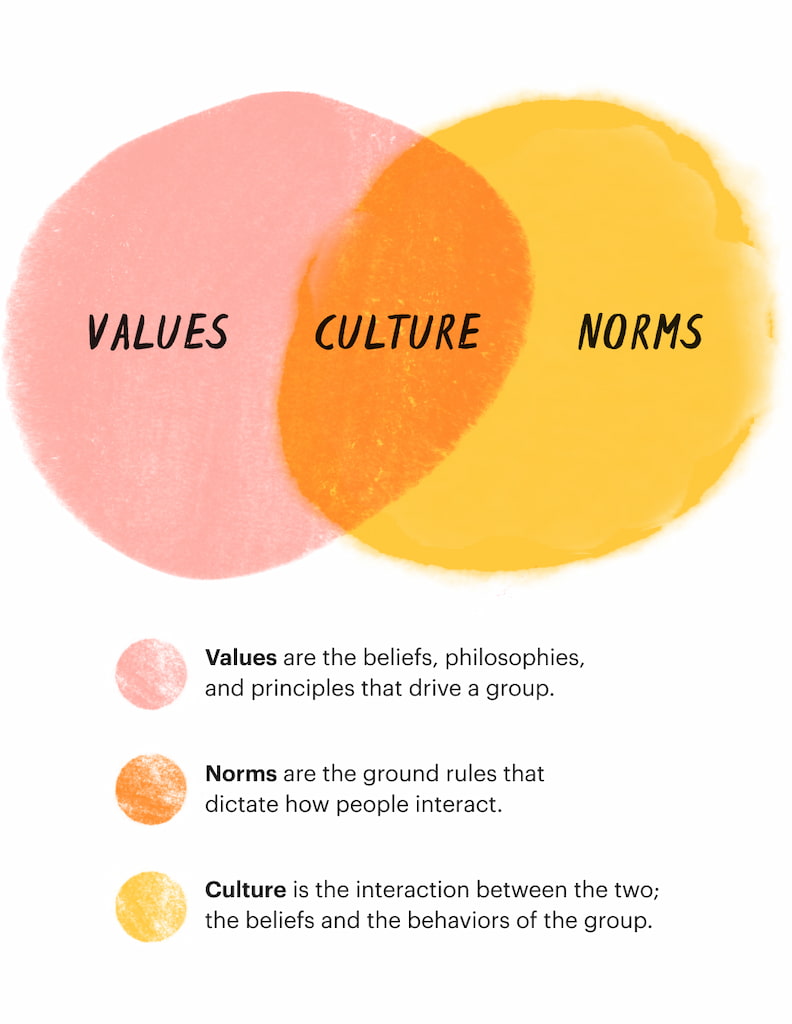Using the best time tracking software can boost team productivity and cohesion. It’s equally important for everyone to understand the group norms, which set expectations for behavior and communication within the team. This article explores what group norms are, the different types, and how to implement them in the workplace.
So, what exactly are group norms? As social creatures, we naturally form bonds and communities. In any group or organization, there are unspoken business rules that members must follow to achieve their goals—these are the group norms. Let’s dive deeper into their definition.
Defining Group Norms: Key Concepts for Teams
Group norms are the informal (spoken or unspoken) rules that team members adopt and adhere to regulate their behavior and help them collaborate more effectively.
These norms can improve communication and make reaching a consensus on decisions easier. In addition, when group members are clear about the expectations and boundaries set by norms, they can focus their energy on the task at hand instead of worrying about what is acceptable behavior.

Group or team norms examples may include:
- Treat every team member with respect
- Encourage free debate and suggestions regarding work
- Celebrate accomplishments – both individual and group
- Don’t engage in “office politics”
- Respect everyone’s time and be on time
- etc
Benefits of establishing group norms
Now that we know what group norms are, let’s dive into the real benefits of establishing them in the workplace.
1️⃣ Group norms give team members a sense of belonging
- Why it matters: A strong team is built on a foundation where everyone feels connected and valued.
- The result: When team members align on norms, they feel psychologically safe, increasing their confidence to share ideas and contribute meaningfully.
2️⃣ Group norms reduce the likelihood of dysfunctional teams
- Why it matters: Dysfunctional teams are unproductive and demotivated. Common issues include lack of trust, accountability, and avoidance of conflict.
- The result: With strong group norms, you’re more likely to foster trust and commitment, which boosts team collaboration and performance.
- Bonus: Healthy team dynamics can also improve collaboration.
By clearly defining and reinforcing group norms, you pave the way for a more cohesive, focused, and successful team.
Types of Group Norms in the Workplace
Group norms play a significant role in how teams function, and they can be divided into various categories. Let’s explore the two primary types: behavior norms and work norms.
1️⃣ Behavior norms
Behavior norms, including group communication norms, set expectations for how individuals interact in the workplace. These norms are critical for creating a respectful and collaborative environment.
Standard behavior norms include:
- 👥 Treating colleagues with respect
- 👂 Engaging in active listening
- 🚫 Avoiding office politics
- 🎉 Celebrating accomplishments
- ⏰ Arriving on time for meetings
- 🗣️ Staying on topic during meetings
2️⃣ Work norms
Work norms govern the performance and productivity of team members. It’s essential to note that deviations from work norms can go both ways.
For example:
- A high-performing team member who goes above and beyond is still deviating from norms, just in a positive way.
- On the other hand, an underperforming team member is seen as a concern.
Examples of work norms include:
- ⏰ Working hours (e.g., 9 am to 5 pm)
- 📝 Completing tasks within a set time frame
- 🔐 Maintaining confidentiality around business operations
- 💼 Demonstrating loyalty to the employer
- 📅 Sticking to meeting agendas
- 📈 Engaging with effective project management strategies
Establishing these norms ensures everyone is on the same page and creates a foundation for efficient team dynamics.
How To Establish Group Norms in the Workplace
Establishing behavioral and work norms takes thought and strategy. Here are some key tips to keep in mind:
✅ Make sure everyone is on board

🔹 Group norms only work if everyone supports them. Without team-wide buy-in, even the best intentions will fall flat. Encourage open discussion during team meetings, interviews, or onboarding to align everyone from the start.
🎯 Be realistic
🔸 Don’t overdo it. Start small and build habits gradually. Setting overly ambitious goals can lead to stress and burnout. It’s better to take small steps consistently than to set unrealistic expectations that demotivate your team.
🗣️ Communicate clearly
🔹 Clear communication from managers is key. Team members should know exactly what is expected of them and how they’ll be held accountable. Use a mix of formats—verbal updates, written guides, visual reminders—to keep norms visible and top of mind.
💬 If norms need to be refreshed, say so openly. Posters, team memos, and team-wide check-ins help reinforce guidelines and show your willingness to support questions or concerns.
🔄 Be flexible
🔸 Teams evolve, and your norms should too. Regularly revisit your expectations to ensure they still fit. This is especially important when working with neurodivergent team members who may not respond well to unwritten or rigid rules.

👁️🗨️ For example, a team member with autism may avoid eye contact. Respecting that difference can help them feel more comfortable. Similarly, someone with ADHD may benefit from shorter, more structured meetings with clear agendas to stay focused.
Manage Work Group Norms With Everhour
⏰ Staying on top of time and task management is key to smooth teamwork. But without the right tool, it can turn into chaos. That’s where Everhour steps in!
🛠️ Everhour helps you build solid work norms with a stack of useful tools. Here’s what’s in your toolkit:
- Time tracker – stay on task and on time
- Time clock – clock in and out with ease
- Work hours tracker – keep tabs on your day
- Attendance tracker – know who’s in and out
- Timesheet app – track time across projects
💸 Pricing at a glance
| Plan | Best for | Key features | Price |
|---|---|---|---|
| Free | Freelancers & small teams |
|
$0 (up to 5 users) |
| Team | Growing or large teams |
|
$8.50/user/month (billed annually) |
💡 Whether you’re a solo freelancer or part of a fast-moving team, Everhour makes it easy to support your group norms and keep everything on track.
In Summary
A solid understanding of a group norm is vital if your business is to succeed. Group norms can provide a framework to help team members adhere to specific behavioral standards and set achievable goals, allowing them to grow in their roles. Understanding and maintaining them makes your team much more likely to thrive!

